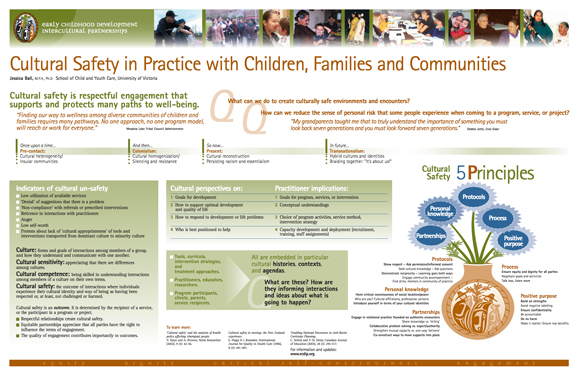Cultural Safety
In her presentation at the BCAPOP Conference in October, Professor Jessica Bell spoke of how “talk of safety conjures its opposites: danger, risk, injury. And this is precisely what the term cultural safety signals: the possibility that some people who seek help from service agencies feel safe and accepted as who they are in terms of their cultural identity and behaviours, while others feel that their cultural identity or behaviours have been disregarded, challenged or harmed as a result of their encounters with health care providers and services.” She stressed that “cultural safety is an outcome”, unlike other concepts such as cultural sensitivity or cultural competence.“The concept of cultural safety asks: How safe did the service recipient experience a service encounter in terms of being respected and assisted in having their cultural location, values, and preferences taken into account in the service encounter?”
Dr. Bell cites examples of where individuals may experience a sense of risk.Many people from indigenous or minority cultural groups have experienced their cultural identity, beliefs, and lifestyles denigrated by service practitioners, including doctors, nurses, teachers, social workers, clergy and others. Also, accessing a service (e.g., traveling to a hospital in a nearby town, meeting a school principal) or participating in a program of care (e.g., entering a substance use treatment program, moving to a long-term care facility) may involve crossing cultural “borders”, to the foreign culture of a mainstream institution, or to a social group composed of people from cultures other than one's own. She point out, “The sense of risk can be mitigated by being accompanied – for example, by an advocate, navigator, or caseworker. This support can provide cultural orientation and mediation both for the service recipient and for the service practitioner.”
Dr. Bell goes on to identify a group of indicators that can flag a perceived lack of safety:
- Low utilization of available services
- ‘Denial’ of suggestions that there is a problem
- ‘Non-compliance’ with referrals or prescribed interventions
- Reticence in interactions with practitioners
- Anger
- Low self-worth
- Complaints about lack of ‘cultural appropriateness’ of tools and interventions offered to participants from a minority culture
She recommends Five Principles to Engender Cultural Safety
- Protocols: Find out about cultural forms of engagement and respect these.
- Show respect:Ask permission/informed consent
- Seek cultural knowledge:Ask questions
- Demonstrate reciprocity:Learning goes both ways
- Engage community accompaniment:Find allies, mentors in community of practice
- Personal knowledge: Become mindful of one’s own cultural identity, socio-historical location in relation to service recipients, pre-commitments to certain beliefs and ways of conceptualizing things like health and wellness.Be prepared to share information about oneself if this will help to create equity and trust.
- Hone critical consciousness of social location/power
- Who are you? Cultural affiliations, professional persona
- Introduce yourself in terms of your cultural identities
- Partnerships: Promote collaborative practice in which those seeking help are also welcomed into a joint problem-solving approach as carriers of important information and know-how.
- Engage in relational practice founded on authentic encounters
- Share knowledge vs. ‘telling’
- Collaborative problem-solving vs. expert/authority
- Strengthen mutual capacity vs. one-way ‘delivery’
- Co-construct ways to move supports into place
- Process:Engage in mutual learning, frequent checking in to ensure that proposed action plans ‘fit’ with service recipient’s values, preferences, and lifestyle.
- Ensure equity and dignity for all parties
- Negotiate goals and activities
- Talk less, listen more
- Positive purpose:Ensure that there is a good probability that positive steps to achieve a service recipient’s goals (or resolve problems) can be taken and that these are likely to be beneficial.Make it matter.
- Build on strengths
- Avoid negative labeling
- Ensure confidentiality
- Be accountable
- Do no harm
- Make it matter:Ensure real benefits
Download the following cultural safety poster:
